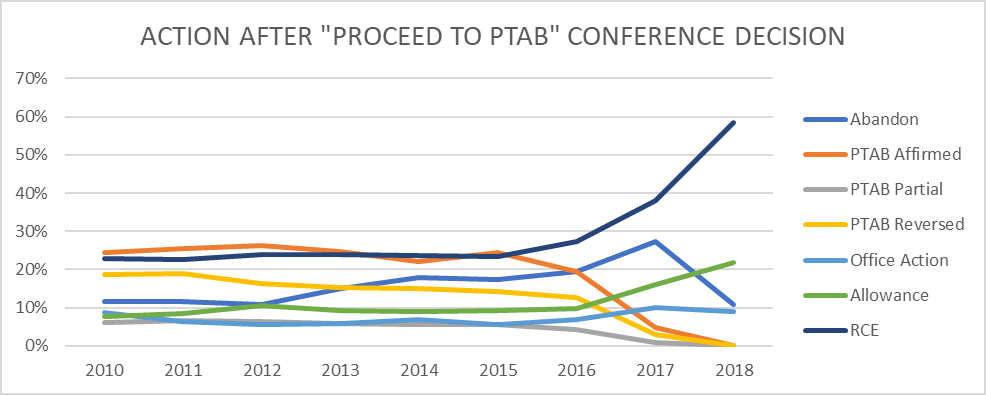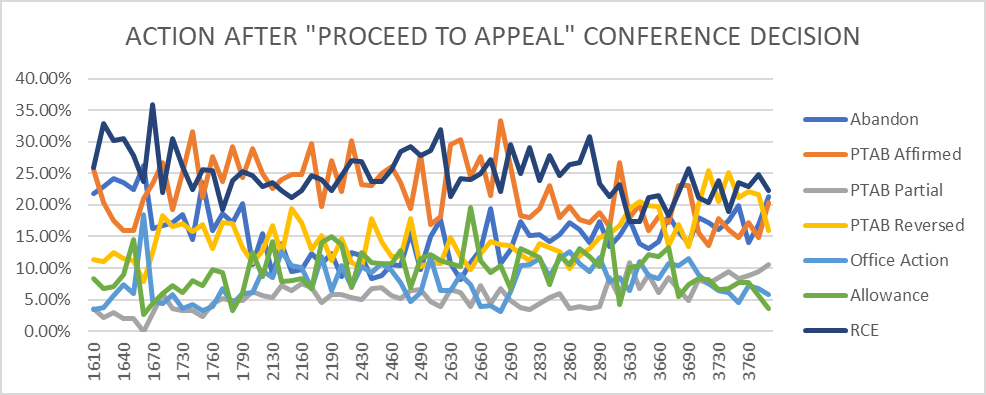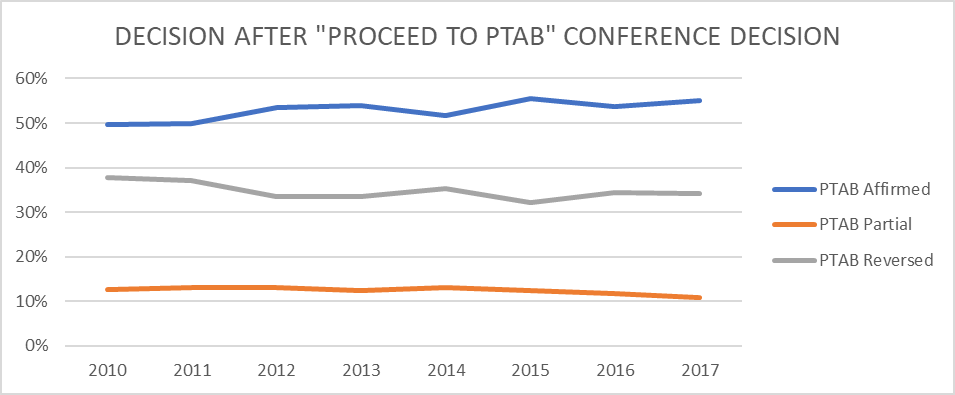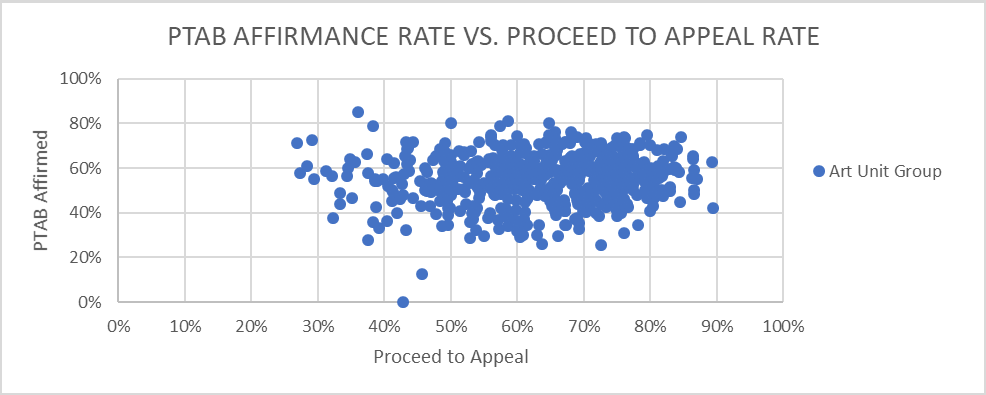For those not familiar with the pre-appeal brief conference pilot program, the USPTO describes it as follows:
This program offers applicants an avenue to request that a panel of examiners formally review the legal and factual basis of the rejections in their application prior to the filing of an appeal brief.
Upon receipt of a properly filed request, a Technology Center Art Unit supervisor will designate a panel of examiners experienced in the field of technology to review the applicant’s remarks and the examiner’s rejections. The panel will include at least a supervisor and the examiner of record. The applicant will not be permitted to attend the review and no interviews will be granted prior to issuance of the panel’s decision.
The panel members will review the rejection(s) identified by applicant in the request. They will also review the application and the appropriate evidence in support of the rejections to the extent necessary. The panel will then decide if an issue for appeal is, in fact, present in the record. The Office should mail a decision within 45 days of receipt of a properly filed request.
Over the years I have made extensive use of the program. My personal experience has led me to the opinion that pre-appeal brief conferences have gotten much less effective over the years and now mostly just get rubber stamped. But given that my last post debunked beliefs I had formed about the Track 1 program, I decided I should test whether my generalizations about the pre-appeal brief program are supported by the data.
Pre-appeal conference decisions of “proceed to PTAB” have gone up only about 10%
It was probably around 2010 to 2012 that I felt pre-appeal conference requests were great. That is, if I felt my client’s position was strong, I fully expected a withdrawal or at least reopening of prosecution, at least saving us the wasted time of appeal (which was excruciatingly long at the time). By 2016, my expectations had completely reversed. I still often file pre-appeal conference requests because: (1) there are no additional fees; and (2) I typically can reuse 90% of the pre-appeal request in a subsequent appeal brief, but I always expect to see the “proceed to appeal” box checked with no further explanation.
Looking at the chart below, it appears once again my individual results are largely coincidental. “Proceed to PTAB” decisions have increased, but only by 10% – an amount much lower than I would have predicted.
Having debunked my theory of drastically increasing “proceed to PTAB” decisions, below are some other metrics for the pre-appeal brief conference program.
Pre-appeal brief conference results vary by about 40% across art unit groups
Applications take many paths after a “proceed to PTAB” panel decision
The below chart answers the question of “Which, if any, of the listed actions is first to happen after a ‘proceed to PTAB’ panel decision?”
Note: Year in the chart above is year of the pre-appeal panel decision. Thus, more recent years are wildly skewed by the fact that the PTAB has not yet rendered decisions in those applications. If we just look at 2015 and earlier, we can see that the next action was pretty consistent from 2010 to 2015.
Note: Most applications where the next action was an allowance or office action involved some sort of interview and/or examiner’s amendment after the “proceed to PTAB” panel decision.
The next chart shows the next action broken down by art unit group (first three digits of the art unit number). Technology centers 3600 and 3700 appear to again be outliers.
If we look at just those applications where a “proceed to PTAB” panel decision went all the way to a PTAB decision, we get the following chart…
~55% of PTAB decisions after a “proceed to PTAB” panel decision are affirmances
So, more often than not, pre-appeal conference panels are justified in believing that their rejections are in line with PTAB precedent. Of course, this picture changes drastically when we start looking at particular art units (see next chart) and particular examiners (discussed further below).
Affirmance rate after a “proced to PTAB” decision varies wildly among art unit groups
“Proceed to PTAB” rate and PTAB affirmance rate are basically uncorrelated
Are art units or examiners that always “proceed to appeal” less likely to be affirmed at the PTAB? Nope. Turns out, the two values are basically uncorrelated. So, again, the best indicator of what you are up against is your particular examiner’s track record (the BigPatentData Examiner Statistics provides pre-appeal conference statistics and appeal statistics for each examiner).
Some examiners/panels are clearly “rubber-stamping” pre-appeal conference decisions
Below is a list of examiners who: (1) have at least 10 PTAB decisions following a “proceed to PTAB” pre-appeal conference decision; and (2) were affirmed in less than 20% of those decisions. These are examiners where you may not want to even bother filing a pre-appeal brief conference request.
| Examiner | PTAB Decisions Following "Proceed to PTAB" | Affirmance Rate |
|---|---|---|
| MAYE, AYUB A | 24 | 4% |
| JENNISON, BRIAN W | 17 | 6% |
| MANCHO, RONNIE M | 16 | 6% |
| CARLOS, ALVIN LEABRES | 12 | 8% |
| ALTER MORSCHAUSE, ALYSSA MARGO | 11 | 9% |
| IPPOLITO, NICOLE MARIE | 11 | 9% |
| PASCHALL, MARK H | 11 | 9% |
| SIEFKE, SAMUEL P | 11 | 9% |
| YABUT, DANIEL D | 11 | 9% |
| REIS, RYAN ALEXANDER | 11 | 9% |
| SZPIRA, JULIE ANN | 11 | 9% |
| HILLERY, NATHAN | 10 | 10% |
| MAHMOOD, NADIA AHMAD | 10 | 10% |
| MARINI, MATTHEW G | 10 | 10% |
| TURCHEN, ROCHELLE DEANNA | 10 | 10% |
| WARD, THOMAS JOHN | 10 | 10% |
| CHUKWURAH, NATHANIEL C | 26 | 12% |
| D ABREU, MICHAEL JOSEPH | 17 | 12% |
| TAWFIK, SAMEH | 17 | 12% |
| WONG, KIN C | 24 | 13% |
| SEVERSON, RYAN J | 16 | 13% |
| BOSWORTH, KAMI A | 15 | 13% |
| SCRUGGS, ROBERT J | 15 | 13% |
| AL HASHEMI, SANA A | 28 | 14% |
| STAPLETON, ERIC S | 21 | 14% |
| HARPER, ELIYAH STONE | 20 | 15% |
| ELVE, MARIA ALEXANDRA | 13 | 15% |
| NGUYEN, VI X | 13 | 15% |
| VAN, QUANG T | 13 | 15% |
| MAYO-PINNOCK, TARA LEIGH | 13 | 15% |
| ROWLAND, STEVE | 12 | 17% |
| BRUTUS, JOEL F | 17 | 18% |
| BATISTA, MARCOS | 22 | 18% |
| CHUNDURU, SURYAPRABHA | 11 | 18% |
| BOSQUES, EDELMIRA | 11 | 18% |
| SCHALL, MATTHEW WAYNE | 11 | 18% |
| SCHMIDT, EMILY LOUISE | 11 | 18% |
| WEEKS, GLORIA R | 11 | 18% |
| NANO, SARGON N | 16 | 19% |
| MALAMUD, DEBORAH LESLIE | 21 | 19% |
Other examiners have impeccable records of affirmance after “proceed to PTAB”
Below is a list of examiners who (1) have at least 10 PTAB decisions following a “proceed to PTAB” pre-appeal conference decision; and (2) were affirmed in more than 70% of those decisions. If you get a “proceed to PTAB” decision from one of these examiners, you might want to give careful consideration to just how strong your position is.
| Examiner | Decisions following "Proceed to PTAB" | Affirmance Rate |
|---|---|---|
| ROBERTS, LEZAH | 22 | 91% |
| PEREZ GUTIERREZ, RAFAEL | 15 | 87% |
| FLEMING-HALL, ERICA L | 14 | 86% |
| SHEPARD, JUSTIN E | 12 | 83% |
| RIGOL, YAIMA | 17 | 82% |
| DAILEY, THOMAS J | 11 | 82% |
| JEBARI, MOHAMMED | 11 | 82% |
| MAPA, MICHAEL Y | 11 | 82% |
| TELAN, MICHAEL R | 11 | 82% |
| CRAWLEY, KEITH L | 10 | 80% |
| PENG, HSIUNGFEI | 10 | 80% |
| RIVERA, JOSHEL | 10 | 80% |
| SHEN, QUN | 10 | 80% |
| SHRESTHA, BIJENDRA K | 10 | 80% |
| TESFAYE, AKLIL M | 10 | 80% |
| TSVEY, GENNADIY | 10 | 80% |
| FANG, PAKEE | 14 | 79% |
| PAN, PEILIANG | 13 | 77% |
| WON, MICHAEL YOUNG | 13 | 77% |
| STARK, JARRETT J | 17 | 76% |
| DENNISON, JERRY B | 20 | 75% |
| AHN, SUNG S | 16 | 75% |
| PATEL, PARTHKUMAR | 16 | 75% |
| COPPOLA, JACOB C | 12 | 75% |
| HOSSAIN, FARZANA E | 12 | 75% |
| KIM, WESLEY LEO | 12 | 75% |
| PIZIALI, ANDREW T | 12 | 75% |
| DEAN, RAYMOND S | 15 | 73% |
| LAZORCIK, JASON L | 15 | 73% |
| BARQADLE, YASIN M | 11 | 73% |
| JACKSON, MONIQUE R | 11 | 73% |
| SURVILLO, OLEG | 11 | 73% |
| TAYLOR, BARRY W | 11 | 73% |
| SWARTHOUT, BRENT | 11 | 73% |
| FABER, DAVID | 14 | 71% |
| FOTAKIS, ARISTOCRATIS | 14 | 71% |
| GREGG, MARY M | 14 | 71% |
| TSENG, CHARLES | 14 | 71% |
| TRAN, PAUL P | 14 | 71% |
| VU, TUAN A | 17 | 71% |









